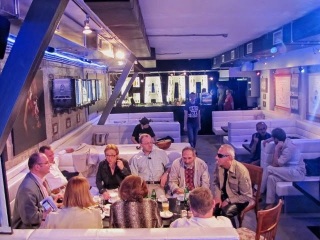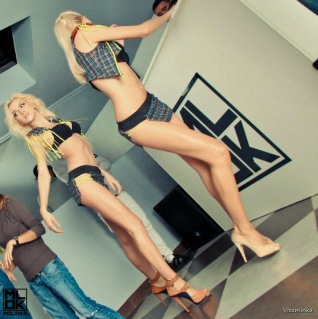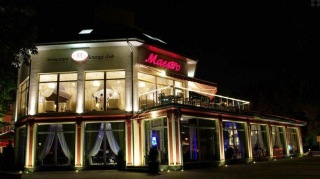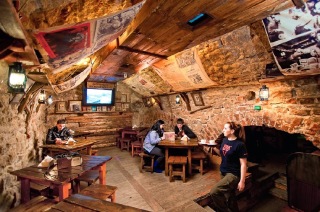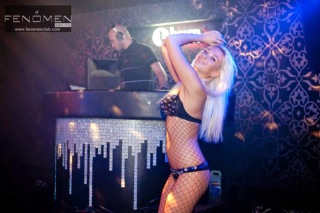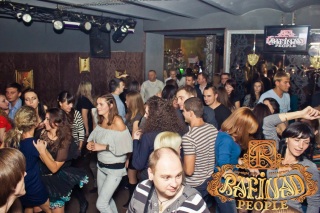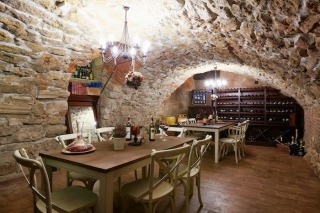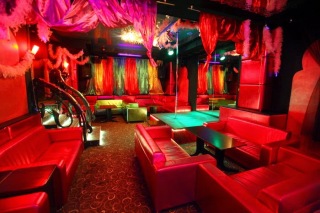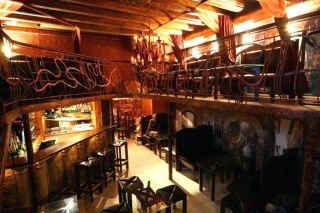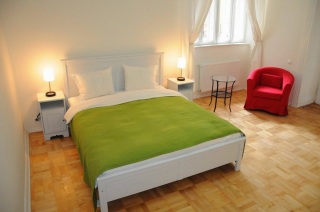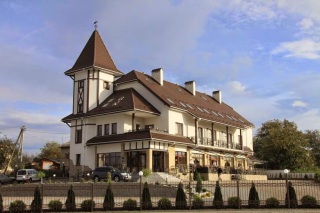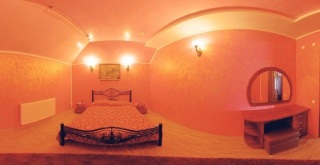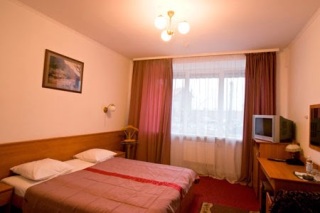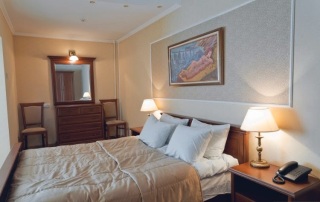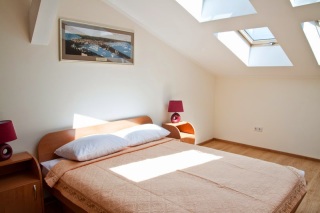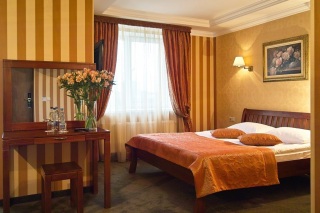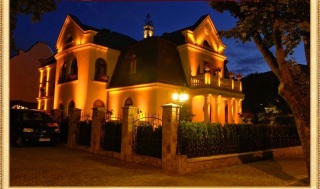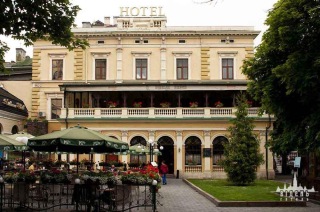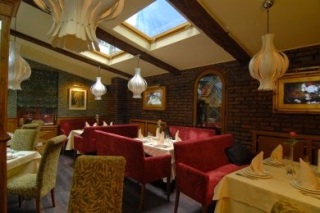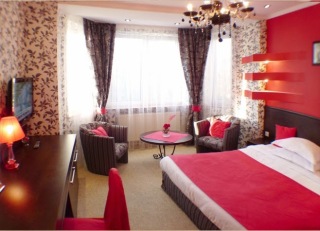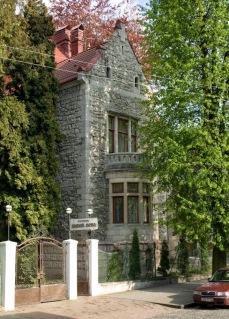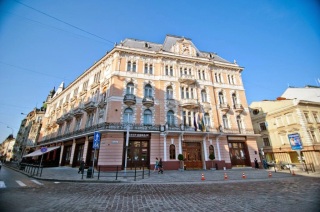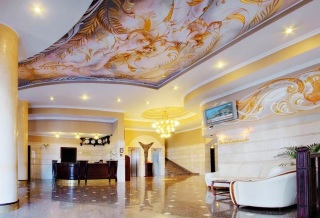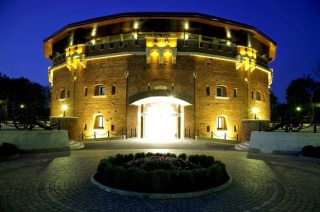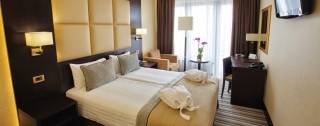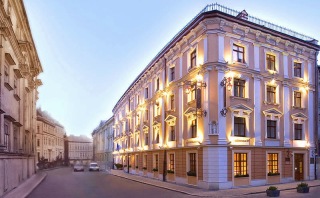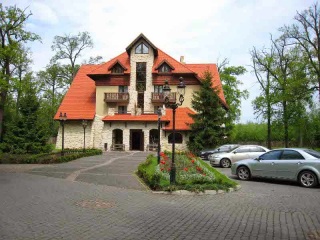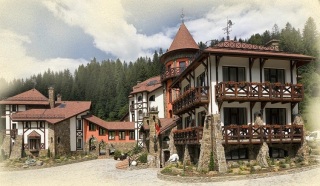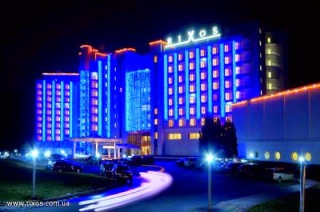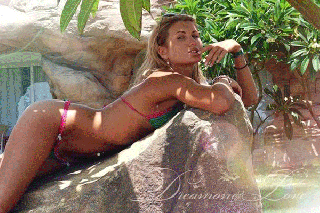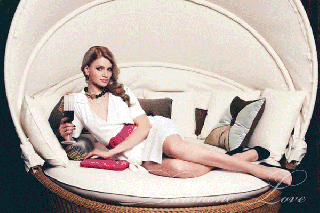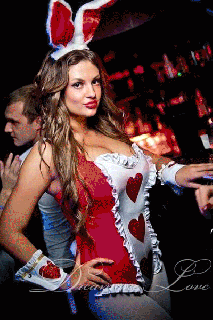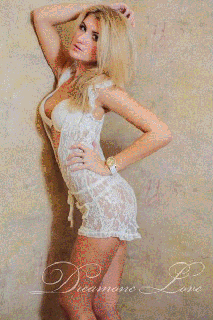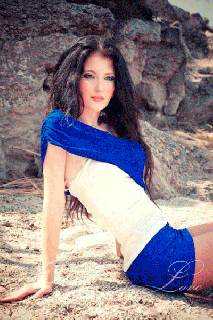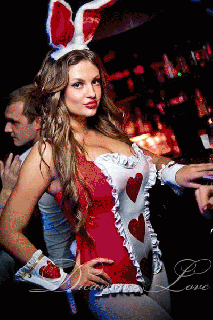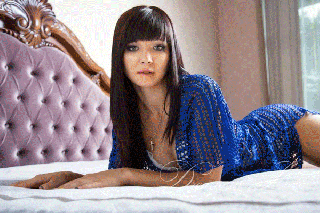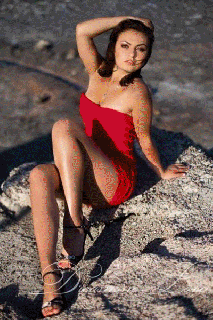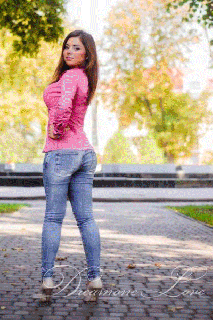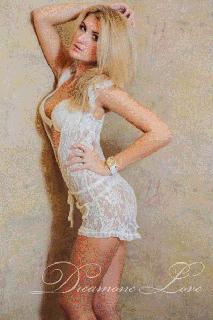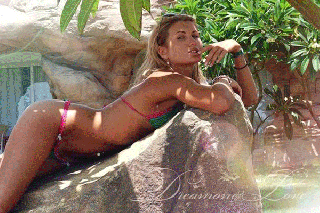1 History
2 Sightseeing
3 Night life
4 Where to stay
1. History of Lviv
Lviv (Ukrainian: Ltspkr.png Львів, L’viv ; Polish: Lwów;German: Lemberg; Yiddish: לעמבערג; Russian: Львов, Lvov, see also other names) is an administrative center in western Ukraine with more than a millennium of history as a settlement, and over seven centuries as a city. Prior to the creation of the modern state of Ukraine, Lviv had been part of numerous states and empires, including, under the name Lwów, Poland and later the Polish-Lithuanian Commonwealth; under the name Lemberg, the Austrian and later Austro-Hungarian Empires; the short-lived West Ukrainian People’s Republic after World War I; Poland again; and the Soviet Union. In addition, both the Swedes and the Ottoman Turks made unsuccessful attempts to conquer the city.
The Old Lviv
Situated just like Rome on seven hills, among the woods, in the valley of the Poltva River, Lviv was always noted for both an advantageous strategic position and an exceptionally beautiful landscape
Once a powerful prince of Halychyna-Volyn Principality Danylo Halytsky traveled through these parts. He stopped here for a moment and realized that he would stay here forever. Burgomaster Bartlomiej Zimorowic, the most distinguished chronicler of Lviv, described this event in the following words: “Seeing at the very border of his domain a hill which was advantageous in military terms, protected down below by a circle of forest-covered valleys and the very steepness which could hold the enemy back, he immediately ordered that a fortress be built here
The City Conquered by Poland. The German Lviv
King of Poland Kazimierz III took advantage of the Principalit’s weakness and managed to conquer Lviv twice, in 1340 and 1349. Several decades later our city fell under the rule of its western neighbours for long centuries to come.
After Lviv became a part of Poland, King Kazimierz did not remain indifferent to the High Castle – this, as a chronicler wrote, “uniquely shaped hill in the Sarmatian land, and built on this sky-high hill a tall stone castle resembling a lute”
Now it is hard to say what made Kazimierz move the city centre from the Old Rynok Square to the swampy plain of the Poltva River. One of the possible reasons is of topographic nature: the old city had no prospects of growth since it was surrounded by hills and woods. But most likely Kazimierz III, being an experience politician, wanted to create in this new location a completely new city which would unconditionally obey the Polish state – and there would be no place left for the subdued Ukrainians in such a city.
The Polish King decided to develop Lviv using the most advanced construction technologies of the time. Unwilling to trust either Ukrainians or his own Polish people, he invited craftsmen and builders from Germany. Thus in the 14th and 15th centuries Lviv became virtually a German city. Even the deeds of Lviv Magistrate were written in Saxon dialect of the German language. Records of the city’s expenditures and taxes collected in the 15th century testify to the fact that Germans formed the majority of Lviv’s population. At that time, Gothic architecture was predominant in the city.
But the year of 1527 brought the most terrible fire in the entire city’s history: the German Gothic Lviv which was similar in appearance to modern Tallinn or Gdansk was burned to the ground. In despair, the inhabitants wanted to leave the city, but later changed their minds and decided to rebuild it. The new Lviv of the second half of the 16th century was a completely different Renaissance city built by Italians. Architects from the Northern Italy, invited to Lviv by the Magistrate, managed to create wonderful examples of Renaissance architecture which combined Italian features with local construction trends.
The Times of Ukrainian Independence
Being an indisputable capital of Ukrainian culture, spirituality and national identity, Lviv has always played a major role in the development of democracy and struggle for Ukraine’s independence.
All state-creating processes related to gaining and consolidating the independence of Ukraine originated in Lviv. It was here that the first mass actions in support of independence were taken; the participants of these actions were persecuted and beaten by special police units.
On September 17, 1989 Lviv became the site of the largest demonstration in support of revival of Ukraine’s independence and the Greek Catholic Church of the time. One hundred thousand people participated in it. The life chain of conciliarism between Lviv and Kyiv on January 21, 1990, when millions of Ukrainians joined their hands, was a landmark on the way to the rebirth of the Ukrainian state. On April 3, 1990 a blue and yellow state flag was hoisted above Lviv City Hall. When the Act on State Independence of Ukraine was passed on August 24, 1991, the following day hundreds of thousands of people flooded the streets of Lviv celebrating this event.
In 1999 Lviv became a sort of capital of Central and Eastern Europe. It was the only city in the entire history of Ukraine to simultaneously receive the heads of nine states during the Summit of Heads of Eastern and Central European States.
Lviv has always been and still remains the detonator of nation-creating and democratic processes in the Ukrainian state. Our city became the main stronghold of the Orange Revolution in November-December 2004, when Ukraine was in the focus of attention of the entire world. Seventy percent of Lviv’s people took part in the actions aimed at defending the democracy in Lviv, and every third resident of the city stood his ground in Maidan Nezalezhnosti in Kyiv. In autumn of 2006 Lviv celebrated its 750th anniversary.
2. Top Lviv attractions
RynokSquare has been the centre of political, public, cultural, and commercial life of the city for 500 years; it is the heart of Lviv, the setting of the historic beginning of the Europeanization of Ukraine. Surrounding it are about fifty unique architectural monuments dating back to the 16-20th
Rynok Square in Lviv has retained its name since the 14th century. It originates from the German “der Ring” (ring, circle), which had been the principle of construction of central squares in German medieval cities.
It was here, in valley of the Poltva River where, in the middle of the 14th century, German colonists commissioned by King Kazimierz III laid the foundations for a classical European town with a market (rynok) square. The Polish king desired to build a town according to the most innovative technologies of the time, and for this purpose he invited craftsmen and constructors from Germany. In the following centuries the architectural perfection of Rynok Square was completed by Italian and Austrian architects.
The Lviv Opera House (28 Svobody Square) is an architectural gem of Lviv, built in the Neo-Renaissance style in 1901, and one of the most beautiful theatres in Europe…
Constructed at the beginning of the 20th century, designed by architect Zygmunt Gorgolewski, the Grand Theatre in Lviv has been compared to the Paris and Vienna opera houses. Standing in front of the magnificent façade of this marvellous building, one can feel the overwhelming power of art, its eternity in contrast with the transience of human life. This building comprises various European architectural styles fashioned in all their lavishness.
Virmenska str. (Armenian Street). The Armenian community, one of the oldest in Lviv, had formed over a period of many years a centre for its national life in Lviv. Its unique architecture portrays the original spirit of this Eastern Christian culture.
The Armenian community, one of the oldest in Lviv, had formed over a period of many years a centre for its national life in Lviv. Its unique architecture portrays the original spirit of this Eastern Christian culture.
Armenians, driven out of their motherland by the Mongol-Tatar invasion of the mid-13th century and having lost their sovereignty, found hospitable refuge in Halychyna. One of the most ancient Eastern Christian nations (Armenians had accepted Christianity several centuries earlier than European nations), the Armenians brought to Lviv a creative sense of search, their capital, and highly skilled jewellers, leather-dressers, and embroiderers. However, they were most proficient in the field of trading. Trade caravans from eastern countries to Europe were almost entirely under an Armenian monopoly. Armenians not only dealt in direct trade but also acted as interpreters through whom all foreign merchants in Lviv worked.
Behind the fence with ornamental metal gate we see a majestic yet refined structure. The imposing palace is decorated with reliefs, mouldings, murals and stained-glass windows. The Palace of Potockis is a bright example of mature historicism architecture and one of the most interesting architectural landmarks of Lviv. It was designed by French architect Louis d’Overnu at the order of governor of Halychyna and Lodomeria Count Alfred II Joseph Potocki (1817-1889). The construction lasted from 1888 to 1890 under the supervision of Lviv architect Julian Tsybulski who also introduced some minor changes.
The Chapel of the Boim family is a famous and very unique late Renaissance monument; it has no analogues, neither in Ukraine nor in the rest of Europe…
The Chapel of the Boim family (Cathedral Square) is a famous and very unique late Renaissance monument; it has no analogues, neither in Ukrainenor in the rest of Europe…
This unique monument adorns Cathedral Square; this lane leads into one of the best views of Rynok Square and City Hall. Georgiy Boim,a Lviv merchant of Hungarian origin, who grew rich trading wine, obtained Lviv citizenship simultaneously with the post of burgomaster, and decided to build a family chapel of unparalleled beauty. The building, designed by Andrzej Bemer, a constructor from Wroclaw, was consecrated in 1615.
The Dominican Church, now the Greek Catholic Church of the Holy Eucharist, is a magnificent monument of the late Baroque; it is adorned with original sculptures.
The Dominican Monastery was founded here in the 13th century upon the request of the wife of Ukrainian Prince Lev Danylovych — the Hungarian Princess Constance, a Catholic, who missed her religion being far from home. A Gothic church stood here from the 15th until the middle of the 18th century.
The Bernardine Monastery (now the Greek Catholic Church of St. Andrew) is an impressive monument in the Renaissance, Mannerism, and Baroque styles dating to1600-1630s. This is a fortified medieval monastery.
Having walked from the direction of Mytna Square, through the fortified gate of the monastery, treading on original wooden cobbles past the Hlynyanska Tower, one will find oneself in the monastery courtyard. Here the spirit of antiquity fills every corner. The bustle of modern life comes to a standstill here as though the last four hundred years of world history have not transpired at all. The Monastery of the Bernardines (the Polish version of the Franciscan order) was built outside the city walls; that is why one sees solid, high fortifications well-preserved on the northern and eastern sides.
The Greek Catholic Archbishop’s Cathedral of Saint George — magnificent Rococo architectural ensemble dating back to the 18th century (comprising a church, bell tower, metropolitan’s palace and capitulary buildings) dominates the high hill over Lviv, beautifully blending into the urban landscape.
An earlier church with a cave monastery was built on this hill in the 13th century by Halychyna-Volyn Prince Lev Danylovych for his uncle Vasylko, who decided to withdraw from secular concerns and dedicate his life to serving God. The current Rococo ensemble was built in the 1760s by architect Bernard Meretyn. Educated in the spirit of Western European architectural traditions Meretyn also introduced elements of Ukrainian religious art in his design.
Passing through the gate adorned with allegorical figures of the Roman and Greek Churches one finds oneself in a large church yard. To the left is the main façade of the Cathedral with its formidable portal and figures of Saints Athanasius and Lev Sheptytsky – high clergymen to whom the cathedral owes its existence. The attic above the portal is topped by a sculptural group of St. George Slaying the Dragon. This brilliant creation by artist Jan Pinsel is one of the best examples of 18th century Lviv sculpture, and it rivals other world masterpieces of the sculptural art.
The Kornyakt Palace (6 Rynok Square) represents an extremely valuable Renaissance monument dating to 1580; it was the palace of the wealthiest citizen in the whole history of Lviv — the merchant Constantine Kornyakt.
Later, it was a Royal Mansion: the property and residence of Polish King Jan Sobieski.
Greek by origin, originally from Crete, Constantine Kornyakt settled in Lviv in the 16th century. He controlled the wine trade along the entire Black Sea coast; he was a benefactor, an experienced and wise man who spoke many eastern languages. Thanks to Kornyakt we can take delight in many marvellous architectural gems of the Renaissance period in Lviv. This stone house was built for him by Italian architect Peter of Barbone in the place of two former houses. According to the laws of the time, all houses situated in Rynok Square could have not more than three windows along the façade; this was a so-called rule of equal opportunity, as each window of the ground floor could be used to accommodate a workshop, a shop, a chemist’s, or for advertising purposes. The richest citizen in Lviv and a merchant, Constantine Kornyakt could not violate this rule; only later, for his services to Polish kings, did he acquire the title of nobleman and a permit to construct a palace with six windows.
The High Castle Park (Uzhhorodska and Knyazha Streets): an old shady park on the hill towering above the city, ruins of an old castle, the viewing platform, and breathtaking sceneries
The highest hill in Lviv (413 meters above the sea level and approximately 130 meters above the level of suburbs) was built artificially in the end of the 19th century in honour of the Union of Lublin. And so Lviv obtained a viewing platform the likes of which can not be found elsewhere in Europe. The views from this platform will not leave anyone who dared go up there indifferent.
City Arsenal is the fortification of XVI centuary, Now in Ukraine is the only museum of weapons.
Once the main entrance to the city arsenal was decorated with the inscription: «Happy Town, which in time of peace is caring about its future security.» Lviv, which was lying at the intersection of major trade routes of East and West, has always been a tasty morsel for all kind of invaders. After the construction of the two castles and fortification line of defense was completed, there was an urgent need for the construction of city arsenal, where had to be manufactured and stored weapons for the defense of the city.
The cemetery has been classified as a historic and cultural museum and heritage preserve.
The cemetery has been classified as a historic and cultural museum and heritage preserve; it occupies a total area of 40 hectares. It was officially founded in 1786 by the new Austrian government in Lemberg (Lviv), which was then the capital of the Austro-Hungarian Kingdom of Galicia and Lodomeria.
3. Night life in Lviv
Lviv is the city of wonders and surprises. It astonishes with its diversity and if you think that entertainment in Lviv is limited to walking tours around historical part of the city, excursions and visiting museums it means you don’t know anything about this city.
Salo is a bit like a museum, but more like a contemporary art space. In the restaurant area you’ll be offered a Salo Art Menu which contains some uniquely sculptured forms of salo. (FYI-Salo is pure pig fat, a Ukrainian delicacy) We liked the chocolate covered salo! There is live music, DJ or something going on every Saturday. One can also order from the menus of neighbouring Bianco Rosso and Yappi restaurants.
Restaurant Club «Play Bar» is styled in white minimalism that creates a special atmosphere of interior space. In daytime fine Italian and European cuisine is served for a business lunch or a friendly meeting. In the evening the atmosphere changes to a nightclub with an excellent dance floor, equipped with modern lighting system (16 million colors and shades). At Thursdays PLAY Jazz Room offers to listen to live jazz and blues or see different performances. An excellent alternative for chic nightlife.
We know how to create a unique atmosphere of a real holiday for you. This is evidenced by the fact that in the opinion of «West Night Life Awards» — FENOMEN best nightlife in Lviv region! Fenomen Club for anyone who feels like on the dance floor irresistible music and an avalanche of trendy dance hits SOLUTION body inflammatory and unrestrained dancing. This club is for anyone who knows the value of true rest and understand that nothing is more relaxing than a cool music hit, unique cocktail from the bartender and easy communication with the opposite sex. So, Fenomen Club invites you on a journey to the phenomenal world. If you are a young, modern, stylish, progressive, this club is for you!
Metro Club is nearly always packed with a local and foreign student crowd. There are 3 different zones, each playing a different type of music. There’s international pop in the Red Phone Hall, which has a seating area with a VIP zone and features the “Nikita&Lolita” travesty show. You can hear R&B in the Bit Beat room, which also has a VIP zone. Metro Hall has a cocktail bar and there the DJ spins house and techno. Metro Club frequently has strip shows to get the crowd going.
Ibiza Cocktail Club is a large beach-themed lounge and disco that features live music, male and female strip shows, and pre-parties on Fridays-Saturdays on the summer terrace starting at 8 p.m. The club’s restaurant serves Continental European and Georgian cuisine. Located just outside Lviv’s center.
Ibiza Cocktail Club is inspired by the Mediterranean party town with same name. There’s a spacious dance floor and cocktail bar zone with 20 tables and a VIP-room with comfy sofas and patio furniture. In warmer weather, you can chill out on the tropical-style summer terrace while listening to lounge and house music. Ibiza attracts a young and democratic, mostly local crowd that enjoys electronic music. Guys, if you’re from out of town, you might want to check out Ibiza on “Jam the Ladies” Thursdays when girls get in free.
SANKOFF is a nightclub outside Lviv’s city center that’s popular with a young crowd. The nightclub has a large dance floor, seats for 250 people, and a stage for live music and shows. The club operates as a lounge-cafe during the day and a karaoke bar in the early evening. Ladies’ Night Thursdays at SANKOFF’ can be worth the trip.
SANKOFF is a popular local hangout that features theme parties like Tropical Night , Angel Night, Ladies’ Night Thursdays, Mafia Night Mondays and Students’ Day Tuesdays. The crowd is young and democratic.
SANKOFF is large compared to Lviv’s other clubs and most of its floor space is devoted to the dance floor and stage.
Moloko (Milk) Club is a downtown Lviv nightclub and restaurant; a hangout for a young and glamorous crowd. The midsize club features a cocktail bar and dance area and an upstairs lounge zone. The 24-hour kitchen serves Continental European and Ukrainian cuisine. Moloko occupies the same space where Gallery Club used to be located.
Moloko Club is a two-level space with a trendy white and black interior. On the second floor there’s a dance floor and cocktail bar zone with 35 seats. On the third floor there’s a lounge zone with comfy sofas for 50 people.
Moloko Club is popular with a young and glamorous crowd, mostly in the 18-25 age range.
Maestro Lounge Club is a large upscale, multilevel restaurant, lounge and disco. It offers several options for dining and leisure: a 2-level restaurant with comfy white sofas, a spacious dance floor and a covered summer terrace. On Fridays and Saturdays the restaurant-lounge turns into a disco for a slightly older (30′s and up) and mostly local crowd.
Maestro Club is quite spacious with several seating options for visitors and large groups, who are looking for something a little posh. During warmer weather, the covered outdoor terrace is usually quite full with a mainly local crowd. The first-floor indoor bar-lounge and dance floor area tends to be pretty quiet during the day and on weeknights. If coming to Maestro for lunch or dinner, then head upstairs to the elegant white dining room. You can find some of Maestro’s best seats on the upper terrace that opens off the upstairs dining room.
“Kryivka” is the very first unique thematic restaurant of Lviv, where cute waitresses in uniform and with sham guns will service you, and, apart from the possibility to taste delicious Ukrainian food, you can even shoot with blanks into the ceiling from different gun of World WarII. The restaurant is located in historical center of the city, on Market Square and is made quite clandestine. When you finally find it out, it appears that the main door is shut. How to enter? Knock the small window and a guard opens a window for you with the exclaim: “Slava Ukrainy” (“Glory to Ukraine”). You need to answer: “Geroyam slava” (“Glory to the Heroes”) and at the very moment you are let in. After this you are offered to drink a small glass of Ukrainian mead vodka and pointed out to the entrance of the restaurant itself through the open doors of the wardrobe you stand by. YES! This is a real “Bandera hideout” (UPA soldier’s dugout). The interior of the restaurant distinctly conveys period look of a real wood dugout of WWII: weapons and different national items of the war… Be sure that your impressions will be unforgettable!
Fenomen is a stylish club with lots of lounge seating that’s a bit outside Lviv’s center. The prices, format and location make the club a destination for Lviv’s young and glamorous.
Fenomen’s prices are a bit high by local standards and ensure a young and fashionable crowd – great if you want to watch the pretty people parade. The club features 3 zones: the Goa-style “Magic Room” for chilling out and access to the terrace, the “Main Room” with VIP zone, bar and dance floor; and the black and white “R&B Room” with a long bar and lounge seating. Each zone has different music.
Rafinad People Club is an upscale nightclub, lounge and strip bar. The downtown club’s plush interior recalls 17th-century France with ornately shaped mirrors and comfy sofas. Rafinad also features 2 VIP rooms and a cigar hall.
Rafinad People is a popular hangout for Lviv’s jet set. The place is more of a lounge than a dance club – the dance floor is quite compact and most of the basement-level club is devoted to seating areas including the VIP rooms. Mixing and mingling can be difficult because the dance floor and bar area are both small, but guys, there’s no shortage of attractive girls.
Party Bar Chocolate is for the young and glamorous and is a frequent hangout for local celebrities. While there is a dance floor, Chocolate feels more like a lounge than a disco with its small comfy sofas, crystal lamps and tiny shiny tables. Besides the cocktail bar and chill-out sections, there’s a VIP zone and a small stage for live performances.
Party Bar Chocolate is often a popular destination for local Lviv celebrities. The crowd is mostly young and glamorous and skews heavily female. The club is not that large compared to other clubs in Lviv and a high proportion of the club’s floor space is devoted to lounge and table seating.
Fashion Club is a downtown Lviv restaurant that becomes a popular, upscale disco in the evening. The dance floor is quite small and can get crowded; it’s surrounded by seating on one side and the main bar on the other. Away from the dance floor there’s a larger room with lots of seats (reservations required) and a smaller back bar. On weekends there are often topless stage dancers to get everyone in the mood. Ladies’ Nights feature male strippers with lots of audience participation. Fashion Club’s large covered terrace is popular in the summertime and no cover charge applies, but reservations are strongly recommended.
Fashion Club is popular with the children of Lviv’s new money, who make the nearby parking lot look like a luxury car dealership.
Enoteca is an upscale wine bar at the Vintage Boutique Hotel. Enjoy the extensive wine selection with fine cheeses and other hors d’oeuvres.
The wine bar has two separate dining areas. The upstairs hall is brightly-lit with 4 small bar tables. Downstairs is the more spacious, dimly-lit wine cellar, which has 2 tables that each seat 5 diners (but be advised that this room can be a bit cool for some guests). Both indoor dining areas at Enoteca are smoke-free. If you’re a smoker, then head outside to the covered summer terrace.
MI100 (known by locals as Misto) is a multipurpose entertainment center with a bowling alley and Lviv’s largest strip bar “The Plush Rhino.” The complex is located outside Lviv’s center and also includes a restaurant with a disco and live music, a karaoke lounge, sport pub, billiards hall and a poker club.
Misto is mostly a locals hangout, but the Plush Rhino can be a good spot for your guy’s night out.Due to its large size and multiple zones, MI100 can seem quite empty especially during the workweek. Weekends draw a mostly local crowd that comes to listen and dance to live music that starts at 10 p.m. The bowling alley tends to be busier on weekend nights.
Zanzibar is an all-in-one complex with a nightclub, strip bar, lounge, billiards hall, and kalian bar, about 3 km outside Lviv’s center. The third floor nightclub has a large dance floor, 2 bars, lots of seating and holds about 300 people. Zanzibar’s club draws a young and democratic crowd and it’s open Wednesday to Sunday from 11 p.m. till dawn. On the first floor you’ll find the strip bar that’s open daily from 10 p.m. to 5 a.m. The lounge, kalian bar and billiards area on the second level are open daily from 12 p.m. till the last client and admission is free.
The crowd at
Zanzibar’s club is young and democratic but strict face and dress control keep out the chavs and chavettes.
Cazanova Lounge-Restaurant morphs from a restaurant to a lounge, and then to a strip bar about 10 p.m.; a good place for your guys’ night out.
You may find
Cazanova’s dark Baroque-style interior a little over the top and kitschy, but you can have a good meal here. On weekends live music starts at 8.pm. During warmer weather Cazanova’s covered terrace is a relaxing place to grab a drink. Another good hot weather option is Cazanova’s air-conditioned loggia (Venetian patio) with natural lighting that creates the illusion that you’re outdoors.
4. Hotels in Lviv
On the Square Guesthouse is a brand new boutique guesthouse hotel located on Rynok Square («Market» or Central Square) of Lviv, Ukraine. We occupy two storeys of an historic building, opposite the main entrance to City Hall. Our hotel offers clean, fresh, new accommodation which has been renovated extensivley, upgraded to contemporary standards in design, furniture and comfort, while retaining many original historic design details.
StatuS Hotel-Restaurant is just outside Lviv on the Kyiv-Chop highway; it’s a good budget option for business travelers or those seeking a quieter accommodation outside the city. The hotel features 21 air-conditioned rooms with wood paneling and a restaurant serving Ukrainian and Continental European cuisine. In warmer seasons guests can enjoy their meal on the covered summer terrace. Free Wi-Fi is available.
StatuS Hotel-Restaurant has 21 rooms including 14 Standard rooms, 1 Semi-Suite (3 single beds or 1 double bed plus single bed), 1 Double Room Suite and 5 Two-level Suites.
Kupava is a small luxurious 13-room hotel located in a grove outside Lviv’s center, and it can be good choice if you’re seeking a quiet place without leaving the city itself. The hotel restaurant serves Continental European and Ukrainian cuisine with several halls decorated in different styles and with curious names like “Ethno-chic” or “Hide from Mother-in-Law”. For business meetings or business seminars Kupava Deluxe Hotel features a small fully-equipped conference room for 30 persons. You’ll also find a spa center with an indoor swimming pool.
Kupava Deluxe Hotel has 13 rooms including 2 Standard Double rooms with single beds, 4 Standard Superior Double rooms, 3 Superior Double rooms, 2 Junior Suites and 2 Suites.
The 53-room
Hotel Sviatoslav offers budget accommodations 9 km outside Lviv’s city center. Services and amenities include free secure parking, a tennis court, conference room, children’s playground, Russian and Roman baths with a small swimming pool. Breakfast is not included in the price of your room. Sviatoslav’s large Ukrainian-style restaurant seats 300 persons with a large dance floor with table service by waitstaff dressed in traditional Ukrainian costumes; a good option for banquets.
Hotel Sviatoslav has 53 De Luxe and Semi Luxe-class rooms: 17 twin rooms with two single beds, 32 double rooms and one apartment De Luxe
The 77-room
Hotel NTON is a good budget option for business travelers when staying in Lviv’s city center is not a must. Hotel services include a restaurant that serves Ukrainian and Continental European cuisine, secure parking, 3 conference halls and a business center. Hotel NTON’s “Pharaoh” fitness complex offers massage services, a gym, Finnish and infrared saunas, a Turkish bath and jacuzzi and a solarium. Free Wi-Fi is also available.
Hotel NTON has 77 single and double rooms of different categories: “Standard”, “Superior Standard”, “Junior” and “Suite”.
The 94-room
Hotel Hetman is located outside Lviv’s center among high-rise apartment buildings. The hotel is a good option for large groups and conferences, or those seeking budget accommodations outside the city center.
Hotel Hetman has a 300-seat conference room as well as smaller assembly halls for 60 and 80 seats and lecture room for 45 seats. 24-hour secure parking is available on-site.
Hotel Hetman has 16 Single rooms, 69 Double rooms, 1 Single Suite, 4 Double Suites and 3 Double Suites for 3 rooms.
With 250 rooms
Hotel Lviv is one of Lviv’s largest hotels. It’s a good combination of central location and lower prices. The hotel was built during the Communist era and has long been a place for budget travelers who didn’t mind Soviet conditions. Recent renovations have brought the Hotel Lviv closer to European standards with modern rooms equipped with air conditioning and satellite TV, including triples and quads for larger parties; junior suites are available if you’re looking for something a tad more “upscale.” Hotel Lviv’s large restaurant serves Ukrainian and Continental European cuisine and has a banquet hall that can hold up to 200 people. Other amenities include secure 24-hour parking and a large conference hall.
Hotel Lviv has 250 rooms including Singles, Doubles, Triples and Quadruple Rooms and 9 Junior Suites.
The Angel Hotel sits on the 4th and 5th floors of a small shopping center and is an excellent option for budget accommodations in Lviv’s historic center. The hotel features spacious and comfortable soundproof rooms with modern interiors. Continental breakfasts are available for an extra charge and served each morning in the breakfast room between 8:00 a.m. and 10:30 a.m.
Angel Hotel offers 10 modern rooms in the following categories: 1 Standard Single Room, 5 Standard Double Rooms, 1 Superior Double Room, 1 Superior Triple Room, 1 Suite (triple) and 1 Suite (double).
Despite being a 20-minute ride outside Lviv’s center, the
Sykhiv Hotel is a good option if you’re looking for a comfortable stay at reasonable prices. The hotel’s modern single and double rooms and elegantly decorated suites will satisfy business travelers and tourists alike. The restaurant offers delicious Ukrainian and Continental European cuisine and is good for business meetings and leisure dining; from May to September you can dine outdoors on the lovely summer patio.
The hotel has Single-Class “Business Comfort” Rooms, Double-Class “Business Comfort” Rooms, Junior Suites and Suites.
Guest House Andriivskyi (Andrew’s) offers luxurious accommodations in well-appointed rooms at upmarket prices. The Old World decor includes a marble staircase and rooms with rich carpets and heavy golden curtains, and a summer terrace with snow-white sofas. Almost all rooms are suites, including the large Ambassador and Presidential suites. The Guest House features a restaurant, provides 24-hour security, free parking and offers transfers by business-class Volkswagen minivan.
The hotel has the following types of rooms: Business Room, Suite Classic, Suite Premium, President Suite, Royal Suite, Ambassador Suite.
The 18-room Hotel at Burger is located in a distinctive 19th century mansion that was restored in 2002. There you’ll find mid-range rooms as well as multi-room suites. The hotel’s large restaurant has three separate areas and holds up to 120 persons, and serves regional Ukrainian and Continental European cuisine. Evenings there often feature live music and strip shows.
The hotel has 18 rooms and suites including Standard, Semi De Luxe and De Luxe. All rooms are soundproof.
The 21-room
Wien Hotel with its elegant banquet hall and the restaurant serving Ukrainian and Continental European cuisine, is a part of the same building as Lviv’s popular
Vienna Coffee House, which has one of the city’s best summer terraces. Breakfast (5 types are available) is included in the room rate and is served in the coffee house from 7:30am till 10:00am. Here you will also find a billiards room and a meeting room for 8-10 persons with a separate entrance to ensure your privacy. The hotel’s banquet hall can be transformed into a conference room for business purposes.
The hotel has 21 rooms, including 11 Standard Rooms, 6 Superior Standard Rooms, 2 Junior Suites and 2 Suites.
The boutique
Swiss Hotel offers comfort and convenience in the heart of Lviv. The hotel features 18 suites, a full-equipped conference hall, and its
Valentino Restaurant serves excellent Italian cuisine. You will also find the beauty salon “The Mask,” one of the city’s top-rated salons.
The Swiss Hotel currently has 18 exclusive suites of 6 different categories: Standard Economy, Standard Superior, Junior Suite, Luxury Suite, Royal and Presidential Apartments.
Hotel «Eney» is a boutique design hotel and is located in the most beautiful, green and quiet area of the ancient centre of Lviv. It is named in honour of Aeneas, a legendary hero of the Trojan War, who is considered to be the founder of Rome, while his son Iul — the progenitor of the Iulius imperial dynasty. Aeneas became close to the Ukrainians through the words of Ivan Kotlyarevskyi, who gave Virgil’s «Aeneid» a new Ukrainian interpretation, making it an encyclopedia of Ukrainians’ life with Aeneas being a Cossack and a national hero. Dialogue and friendly conversation of contrasts — Greek-Latin classical style and post-modern — are put into the Hotel’s interior design.
The Lion’s castle hotel appeared on the Glinka street at 1991 year as a result of joint ukrainian and canadian enthusiasts’ efforts, which is known as U-can interservice ltd. Now it is the Lion’s castle ltd.The aim of the businessmen was to create the unique place in Lviv, where everyone can feel like at home owing to excellent service, friendly hospitality, high ethical principles and intellictual standards. We are keeping and developing these traditions of warm hospitality for more than 20 years.
Hotel offers 13 spacious and individually decorated rooms equipped with all necessary for Your stay plus complimentary coffee and tea making facilities.
The boutique-size Lion’s Castle Hotel is nestled between two leafy parks in a quiet neighborhood. The hotel offers 14 rooms in neo-romantic style in two turn of the century buildings. You can choose from the rich and royal “Castle” or the spacious and elegant “Austrian Luxe.” The hotel’s Green Hills Park Cafe has a lovely covered summer terrace and is a good dining option for visitors to nearby Stryiskyi Park. Business facilities include a conference hall for 30 persons. The Lion’s Castle Hotel is equally suitable for families and business travelers.
The 91-room
Eurohotel is an excellent choice for business travelers seeking quieter environs just outside Lviv’s center. The hotel’s elegant restaurant serves Ukrainian and Continental European cuisine, and has a banquet hall for large groups. The Eurohotel also features a fully-equipped business center and conference hall.
The
Eurohotel has 6 Single Rooms, 76 Double and Twin Rooms, 5 Junior Suites, 4 Suites and 2 Apartments.
George Hotel
It is an exceptional monument of architecture, founded in 1901 by prominent Austrian architects Herman Helmer and Ferdinand Felner in a style of Neo-Renaissance. The hotel is worth being visited by the connoisseurs of beauty from all over the world.
After the renovation an exquisite hotel with luxurious rooms and a marvelous panoramic view of Old Lviv has been created, with the ideal combination of perfection of the European service and the Ukrainian hospitality in the very city centre.
Cosy and comfortable rooms, bar and restaurant with delicious European kitchen, professionalism and courtesy of George Hotel personnel are at your disposal.
The hotel has 90 rooms including Suites, Junior Suites, Superior Rooms, Standard Rooms and Tourist Class Rooms.
The high-end Opera Hotel enjoys an excellent central location. The hotel has 51 well-appointed rooms, a conference hall and a meeting room. The roof-top restaurant Panorama offers some of the best views and food in the city year-round. During warmer weather, the restaurant’s terrace is great place to enjoy open air dining.
Hotel Opera has 8 Single Rooms, 33 Double Rooms, 5 Suites and 5 Junior Suites.
The luxurious 26-room Citadel Inn Hotel & Resort has a unique architectural history. It was built using Fort II that had been part of the fortifications defenses of the eastern approach to the Lviv Citadel during the city’s Austro-Hungarian period. The rooms are executed in a refined, ornate style, and the hotel’s well-equipped conference hall that can accommodate up to 50 people. Diners at the Citadel’s Garmata Restaurant can enjoy some of the best views of Lviv from the walk around terrace.
Citadel Inn Hotel & Resort has 26 rooms, including Standard Rooms, Superior Rooms and Suites.
Dnister Hotel built in 1983 is situated on a picturesque hill near the old park. This is the place where at the end of XIX century Polish artists created several fragments of famous Raclawicka Panorama painting. Later the painting was exhibited in a special rotunda in Stryiski park and was one of the main sightseeings of the city.
During Soviet times the hotel belonged to Intourist chain was a flagship of a hospitality industry of the city. In September 1999 Dnister Hotel was awarded with 4 star rating.
Dnister is a traditional venue for international events of high level. Among the celebrities–first lady of the United States of America Hillary Clinton, Polish President Alexander Kwaśniewski, Ukrainian President Leonid Kuchma, Czech President Václav Havel, Presidents of Austria, Bulgaria, Germany, Romania, Slovenia, Hungary.
Leopolis is the only luxurious boutique hotel in Lviv located right in the heart of historical part where you can still feel the romanticism spirit and the old city Bohemian atmosphere. The hotel is a perfect place for rest after a vigorous tourist walk or after a business meeting. Leopolis is located in the restored building that is listed as a UNESCO World Heritage Site. It’s a great place to explore history, culture and entertainment that are vastly offered by Lev’s City.
Only one minute walk from the Market Place, 4 minutes from the Opera Theatre, 3 minutes from the Vernissage, and 15 minutes from St. George Cathedral. Whatever you want to see in Lviv first – everything is located right near Hotel Leopolis.
Our hotel offers you 72 exclusive rooms including 3 Suites and 3 superb Executive Suites. By virtue of the pastel colours of the interior and soft lighting our hotel always oozes with comfort and cosiness. Italian furniture, luxurious interior and spacious bathrooms will please even the most demanding guests. Satellite TV, wireless internet access, flat screen TVs, luxurious cosmetic sets, round-the-clock room service – all of these will help make your stay as comfortable and memorable as possible.
The charming Park-Hotel “Drevny Grad” is located just outside Lviv’s city limits and is a good option if you’re seeking a quieter place and don’t mind a little travel time to the center. This medieval-style hotel with stone fortifications and wooden walls features 34 rooms and 35 cottages. The Park-Hotel ”Drevny Grad” has two kinds of sauna, a restaurant serving authentic Ukrainian cuisine, 2 conference halls for 50 and 170 seats, and free 24-hour parking.
The Park-Hotel “Drevny Grad” has 20 Double standard rooms, 8 Deluxe rooms, 2 Junior Suites, 4 Two-level Junior Suite rooms, and 35 Two-level Cottages.
Vezha Vedmezha is an upscale hotel and entertainment complex located in the Carpathian Mountains not far from the Slavs’ke ski area. The hotel’s name means “The Bear’s Tower” and it comes from a local legend about an enormous she-bear that saved a brave knight on the very site where the resort now stands. Along with Bukovel, Vezha Vedmezha is one of the most well-known ski and spa-resorts in the Ukrainian Carpathians, with year-round options for active leisure, including hiking, mountain skiing and horseback riding. At Vezha Vedmezha you can get great tours of the mountains, see the popular Synevyr Lake (located at almost 1 km above sea level), or explore the mysterious ruins of nearby Tustan Fortress.
The hotel of Vezha Vedmezha has 25 rooms that include 18 Double Standard Rooms, 2 Double Superior Rooms 4 Two-Room Deluxe Suites and 1 Three-Room Deluxe Suite. The hotel also features 1 apartment (Luxury two-level suite).
Rixos-Prykarpattya is an upscale diagnostic center and rehabilitation resort with a full range of recreation and entertainment options, including a medical center, hotel, spa with mini aquapark, tennis courts and more. There are 2 fine restaurants, 6 bars and 3 fully-equipped conference halls, as well as entertainment centers for children. Rixos-Prykarpattya’s top notch accommodations and entertainment complex make it a popular venue for weekend getaways, conferences and other corporate events.
The hotel of Rixos-Prykarpattya features 369 elegantly-decorated rooms,
 Of the few remaining fortifications from the times of Prince Yaroslav the Wise (1019-1054), the Golden Gate is the most remarkable. IN 1983 the ruins of the Golden Gate, built as a defensive structure, were restored to their present condition. The same year, the Golden Gate Museum was opened. The ground floor contains exhibits relating to the history of old Kiev. The halls display armaments used by the ancient Kievites and other excavations from the site of the Golden Gate. The balconies of the museum offer a panoramic view of Kiev.
Of the few remaining fortifications from the times of Prince Yaroslav the Wise (1019-1054), the Golden Gate is the most remarkable. IN 1983 the ruins of the Golden Gate, built as a defensive structure, were restored to their present condition. The same year, the Golden Gate Museum was opened. The ground floor contains exhibits relating to the history of old Kiev. The halls display armaments used by the ancient Kievites and other excavations from the site of the Golden Gate. The balconies of the museum offer a panoramic view of Kiev. In the year 1744 the Russian Empress Elizabeth was visiting the home-land of her favorite Alexey Rozumovsky and decided to build her summer residence here. She herself laid the first symbolic brick of the new palace and church. A famous Italian architect Bartolomeo Rastrelly supervised the construction. Now the church-museum catches the eye of the visitors straight away. Its beauty and the aura of history make the place a must for visitors.
In the year 1744 the Russian Empress Elizabeth was visiting the home-land of her favorite Alexey Rozumovsky and decided to build her summer residence here. She herself laid the first symbolic brick of the new palace and church. A famous Italian architect Bartolomeo Rastrelly supervised the construction. Now the church-museum catches the eye of the visitors straight away. Its beauty and the aura of history make the place a must for visitors. Andriyivsky Uzviz was the shortest way from the Upper city to Podil. The name was known from 18 the century. In 1753 was built St. Andrew’s Church (B.F. Rastrelli). By the legend, in times immemorial, there was the sea where the Dnipro River flows now. When St. Andrew came to Kiev and erected the cross on the hill where now St. Andrew’s Church stands, the sea drained away. But a part of it remained and hid under the hill. When later the church was built there, a stream opened under the altar. That is why there are no bells at St. Andrew’s Church, as with the first bell stroke water would awaken and flood not only Kyiv but the entire territory of the left bank of the Dnipro. Main structure executed in the 90s of the 19 century and at the beginning of the 20 century. Rebuilt as before is the place of exhibition — sale of paintings and folk creative works in the open air. Andriyivsky Uzviz is called Kyiv’s Monmartre. If you go there on any day of the year, regardless of weather, you will see quite a few artists showing their pictures, hung on the walls and fences, applied- and decorative-art artists displaying their wares right on the sidewalk or on little stands — rings, brooches, necklaces, embroidered shirts, earthenware of most unusual shapes and forms, curious creations made of wood and other materials, to red banners sporting various slogans, uniforms, medals, coins and other paraphernalia of the defunct regime.
Andriyivsky Uzviz was the shortest way from the Upper city to Podil. The name was known from 18 the century. In 1753 was built St. Andrew’s Church (B.F. Rastrelli). By the legend, in times immemorial, there was the sea where the Dnipro River flows now. When St. Andrew came to Kiev and erected the cross on the hill where now St. Andrew’s Church stands, the sea drained away. But a part of it remained and hid under the hill. When later the church was built there, a stream opened under the altar. That is why there are no bells at St. Andrew’s Church, as with the first bell stroke water would awaken and flood not only Kyiv but the entire territory of the left bank of the Dnipro. Main structure executed in the 90s of the 19 century and at the beginning of the 20 century. Rebuilt as before is the place of exhibition — sale of paintings and folk creative works in the open air. Andriyivsky Uzviz is called Kyiv’s Monmartre. If you go there on any day of the year, regardless of weather, you will see quite a few artists showing their pictures, hung on the walls and fences, applied- and decorative-art artists displaying their wares right on the sidewalk or on little stands — rings, brooches, necklaces, embroidered shirts, earthenware of most unusual shapes and forms, curious creations made of wood and other materials, to red banners sporting various slogans, uniforms, medals, coins and other paraphernalia of the defunct regime. ST.SOPHIA CATHEDRAL Was built in the first half of the 11th century to commemorate the victory over the Pecheneg tribe. Here you will see portraits painted by unknown painters of the past, will be able to read frescoes on the walls (the 11th century) — people’s requests to God, great mosaics (some of them were so unique, that they were stolen by Nazis during the Second world war and are preserved in German museums now). The cathedral preserves a sarcophagus with the remains of Prince Volodymyr. St Sophia is rightfully considered as the treasure of Ukraine and is protected by UNESCO.
ST.SOPHIA CATHEDRAL Was built in the first half of the 11th century to commemorate the victory over the Pecheneg tribe. Here you will see portraits painted by unknown painters of the past, will be able to read frescoes on the walls (the 11th century) — people’s requests to God, great mosaics (some of them were so unique, that they were stolen by Nazis during the Second world war and are preserved in German museums now). The cathedral preserves a sarcophagus with the remains of Prince Volodymyr. St Sophia is rightfully considered as the treasure of Ukraine and is protected by UNESCO. ST.MICHAEL`S MONASTERY The Archangel Michael is considered to be the patron of Kyiv. Perhaps that is why the recently restored St. Michael’s Monastery of the Golden Roof is especially dear to Kyivans. Its beauty makes an unforgettable impression. This religious complex is situated just opposite Sophia Cathedral and seems to reign on the steep bank of the Dnipro in all its glory. This precious Kyivan relic, sky-blue in color, with its golden glitter of cupolas and vividly decorated arches, rich services and wonderful choirs, is matchless in the delicacy and splendor of its architecture and decoration. The entire complex — from the perfectly planned territory of the monastery to the tolling of the bells (you can strike the bell if you ascend to the top floor of the bell-tower) — is a model of taste and refined aestheticism.
ST.MICHAEL`S MONASTERY The Archangel Michael is considered to be the patron of Kyiv. Perhaps that is why the recently restored St. Michael’s Monastery of the Golden Roof is especially dear to Kyivans. Its beauty makes an unforgettable impression. This religious complex is situated just opposite Sophia Cathedral and seems to reign on the steep bank of the Dnipro in all its glory. This precious Kyivan relic, sky-blue in color, with its golden glitter of cupolas and vividly decorated arches, rich services and wonderful choirs, is matchless in the delicacy and splendor of its architecture and decoration. The entire complex — from the perfectly planned territory of the monastery to the tolling of the bells (you can strike the bell if you ascend to the top floor of the bell-tower) — is a model of taste and refined aestheticism. MUSEUM OF FOLK ARCHITECTURE Entrance fee $1.00; $10.00 per person for English-speaking guide. Located in the outskirts of Kyiv, this open air museum takes you through Ukraine’s history as you walk through the original homes of the past which have been moved here from all corners of Ukraine and restored. Traditional Ukrainian costume and ceramics are on exhibit. The open-air museum is set on 150 hectares of picturesque terrain on the southwestern outskirts of Kyiv. It was founded in the late 1960’s, and in 1976 it was opened to the public. To date, the museum has over 200 structures moved here from various regions of the Ukraine or econstructed on the spot. The museum has some 40,000 ethnographic exhibits, including folk costumes, fabrics, embroidery, carpets, ceramics, articles of metal, wood, glassware, musical nstruments, paintings, tools, household articles and the like. These objects are exhibited both inside the cottages and other farm buildings and in the permanent exhibition halls
MUSEUM OF FOLK ARCHITECTURE Entrance fee $1.00; $10.00 per person for English-speaking guide. Located in the outskirts of Kyiv, this open air museum takes you through Ukraine’s history as you walk through the original homes of the past which have been moved here from all corners of Ukraine and restored. Traditional Ukrainian costume and ceramics are on exhibit. The open-air museum is set on 150 hectares of picturesque terrain on the southwestern outskirts of Kyiv. It was founded in the late 1960’s, and in 1976 it was opened to the public. To date, the museum has over 200 structures moved here from various regions of the Ukraine or econstructed on the spot. The museum has some 40,000 ethnographic exhibits, including folk costumes, fabrics, embroidery, carpets, ceramics, articles of metal, wood, glassware, musical nstruments, paintings, tools, household articles and the like. These objects are exhibited both inside the cottages and other farm buildings and in the permanent exhibition halls MARIINSKIY PALACE Mariinsky Palace, which was built in the middle of the 18 century by V.Rastrelli in the baroque style, was intended to echo Versailes in miniature. During the last war it was badly damaged but was reconstructed, and is now a part of the Supreme Rada’s premises. In 1936, the government moved into Pechersk and redeveloped many of of old estates: the grandiose building of the Council of Peoples’ Commisars. This huge building, now occupied by the Cabinet of Ministers, was designed by the architects Ivan Fomin and Pavel Abrosimov in the Soviet neoclassical style.
MARIINSKIY PALACE Mariinsky Palace, which was built in the middle of the 18 century by V.Rastrelli in the baroque style, was intended to echo Versailes in miniature. During the last war it was badly damaged but was reconstructed, and is now a part of the Supreme Rada’s premises. In 1936, the government moved into Pechersk and redeveloped many of of old estates: the grandiose building of the Council of Peoples’ Commisars. This huge building, now occupied by the Cabinet of Ministers, was designed by the architects Ivan Fomin and Pavel Abrosimov in the Soviet neoclassical style. The Adria Hotel is 12 km from the city center. The Livoberezhna metro station (15 minutes to center) and bus station are near the hotel. The Borispol International Airport is 30 km away from the hotel; the Central Railway Station is 17 km away.
The Adria Hotel is 12 km from the city center. The Livoberezhna metro station (15 minutes to center) and bus station are near the hotel. The Borispol International Airport is 30 km away from the hotel; the Central Railway Station is 17 km away.

 The Premier Palace Hotel was originally built on the edge of the 19th — 20th centuries. The windows of the hotel offer a wonderful view over the gorgeous golden domes of Kiev`s churches. The hotel both reflects the past and is a step into the future at the same time. The hotel has been entirely reconstructed in the past years, and today it fully complies with the world standards.Spacious comfortable rooms equipped with the newest facilities, excellent service, exquisite menu and a wide range of additional services await the guests of the hotel.
The Premier Palace Hotel was originally built on the edge of the 19th — 20th centuries. The windows of the hotel offer a wonderful view over the gorgeous golden domes of Kiev`s churches. The hotel both reflects the past and is a step into the future at the same time. The hotel has been entirely reconstructed in the past years, and today it fully complies with the world standards.Spacious comfortable rooms equipped with the newest facilities, excellent service, exquisite menu and a wide range of additional services await the guests of the hotel.
 The 17-storied building is individually designed and has three high-speed elevators for the guests` convenience. From the windows of the hotel the fascinating view of the city is revealed.
The 17-storied building is individually designed and has three high-speed elevators for the guests` convenience. From the windows of the hotel the fascinating view of the city is revealed. The popular Kiev River Boat Station is situated 1 km from the Dnipro Hotel, where the guests can get by a 15-minute walk along the most beautiful streets of the city, Vladimirsky Spusk and Pochtovaya Street.
The popular Kiev River Boat Station is situated 1 km from the Dnipro Hotel, where the guests can get by a 15-minute walk along the most beautiful streets of the city, Vladimirsky Spusk and Pochtovaya Street. Hyatt Regency Kiev Hotel offers accommodation in 234 comfortable rooms (including 25 suites) with all modern amenities and wide range of hotel facilities, among them fitness center, swimming pool, Grill Asia restaurant and bar. Meeting facilities of Hyatt Regency Kiev Hotel include 8 meeting rooms, 3 board rooms and business center. Both business and tourist guests will appreciate high-qualified service and helpful multilingual staff of the hotel.
Hyatt Regency Kiev Hotel offers accommodation in 234 comfortable rooms (including 25 suites) with all modern amenities and wide range of hotel facilities, among them fitness center, swimming pool, Grill Asia restaurant and bar. Meeting facilities of Hyatt Regency Kiev Hotel include 8 meeting rooms, 3 board rooms and business center. Both business and tourist guests will appreciate high-qualified service and helpful multilingual staff of the hotel. Ramada Worldwide is one of the 17 brands in the Wyndham Hotel Group (WHG), one of the largest hotels chain worldwide boasting 7,190 hotels with 609,000 guest rooms located in 65 countries covering 6 continents.
Ramada Worldwide is one of the 17 brands in the Wyndham Hotel Group (WHG), one of the largest hotels chain worldwide boasting 7,190 hotels with 609,000 guest rooms located in 65 countries covering 6 continents. The venue is split into three parts with a hookah bar downstairs covered with Moroccan style lanterns, rugs and cushions. The main dance floor on the first floor encompasses the oval shaped bar; whilst the floor for karaoke is up on second. Dancing on their only small platform next to the mixing deck is not balked at by the bouncers and jostling for space wasn’t an issue during my visit, even when things got into full swing.
The venue is split into three parts with a hookah bar downstairs covered with Moroccan style lanterns, rugs and cushions. The main dance floor on the first floor encompasses the oval shaped bar; whilst the floor for karaoke is up on second. Dancing on their only small platform next to the mixing deck is not balked at by the bouncers and jostling for space wasn’t an issue during my visit, even when things got into full swing. III-floor — the club area with a large stage, where popular artists and singers perform on Friday and Saturday.Here is a home for finest capital’s events, concerts and presentations conducted by best anchors.
III-floor — the club area with a large stage, where popular artists and singers perform on Friday and Saturday.Here is a home for finest capital’s events, concerts and presentations conducted by best anchors. The entertaining complex «Avalon» has been founded in 2003. Under its roof are the vocal restaurant Pavlin, disco-club Azhur, lounge-bar and casinohave taken places. The complex philosophy consists that any visitor of an institution will necessarily find here the vacation spot with an excellent interior and irreproachable service.
The entertaining complex «Avalon» has been founded in 2003. Under its roof are the vocal restaurant Pavlin, disco-club Azhur, lounge-bar and casinohave taken places. The complex philosophy consists that any visitor of an institution will necessarily find here the vacation spot with an excellent interior and irreproachable service.



















































